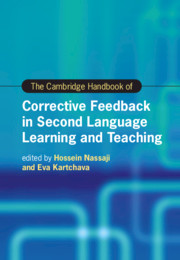Book contents
- The Cambridge Handbook of Corrective Feedback in Second Language Learning and Teaching
- Cambridge Handbooks in Language and Linguistics
- The Cambridge Handbook of Corrective Feedback in Second Language Learning and Teaching
- Copyright page
- Contents
- Figures
- Tables
- Contributors
- Acknowledgments
- Introduction Corrective Feedback in Second Language Teaching and Learning
- Part I Theoretical Perspectives on Corrective Feedback
- Part II Methodological Approaches in the Study of Corrective Feedback
- Part III Different Delivery Modes of Corrective Feedback
- Part IV Feedback Provider, Feedback Intensity, and Feedback Timing
- Part V Corrective Feedback and Language Skills
- Part VI Contexts of Corrective Feedback and Their Effects
- Part VII Learners’ and Teachers’ Feedback Perspectives, Perceptions, and Preferences
- 26 Teachers’ and Students’ Beliefs and Perspectives about Corrective Feedback
- 27 Written Corrective Feedback and Learners’ Objects, Beliefs, and Emotions
- 28 The Role of Training in Feedback Provision and Effectiveness
- 29 Perceptions and Noticing of Corrective Feedback
- Part VIII Individual Differences, Tasks, and Other Language- and Learner-Related Factors
- Index
- References
27 - Written Corrective Feedback and Learners’ Objects, Beliefs, and Emotions
from Part VII - Learners’ and Teachers’ Feedback Perspectives, Perceptions, and Preferences
Published online by Cambridge University Press: 26 February 2021
- The Cambridge Handbook of Corrective Feedback in Second Language Learning and Teaching
- Cambridge Handbooks in Language and Linguistics
- The Cambridge Handbook of Corrective Feedback in Second Language Learning and Teaching
- Copyright page
- Contents
- Figures
- Tables
- Contributors
- Acknowledgments
- Introduction Corrective Feedback in Second Language Teaching and Learning
- Part I Theoretical Perspectives on Corrective Feedback
- Part II Methodological Approaches in the Study of Corrective Feedback
- Part III Different Delivery Modes of Corrective Feedback
- Part IV Feedback Provider, Feedback Intensity, and Feedback Timing
- Part V Corrective Feedback and Language Skills
- Part VI Contexts of Corrective Feedback and Their Effects
- Part VII Learners’ and Teachers’ Feedback Perspectives, Perceptions, and Preferences
- 26 Teachers’ and Students’ Beliefs and Perspectives about Corrective Feedback
- 27 Written Corrective Feedback and Learners’ Objects, Beliefs, and Emotions
- 28 The Role of Training in Feedback Provision and Effectiveness
- 29 Perceptions and Noticing of Corrective Feedback
- Part VIII Individual Differences, Tasks, and Other Language- and Learner-Related Factors
- Index
- References
Summary
Research on written corrective feedback (WCF) has tended to focus on the product; that is, the impact of WCF on learners’ accuracy in revised or new texts. In this chapter I use activity theory (AT) as a theoretical framework to consider learners’ response to feedback as a situated social activity. I argue that in order to understand how and why learners respond to teacher written corrective feedback (WCF), we need to consider the individual affective variables that drive human behavior and their interaction with contextual elements inherent in the immediate and broader social context in which the feedback activity takes place. Drawing on the small body of available research, I consider three key affective factors, namely learners’ goals and perceived language needs, captured by the term object in AT; learners’ beliefs about L2 writing and what constitutes effective feedback; and learners’ emotional reaction to the nature and quantity of the feedback received. I then discuss the interaction of these affective factors with contextual elements such as interpersonal relationships, power hierarchies, and expectations. I conclude by suggesting pedagogical practices and areas of future research that will provide us with a greater understanding of the processing and outcomes of WCF on L2 writing.
Keywords
- Type
- Chapter
- Information
- The Cambridge Handbook of Corrective Feedback in Second Language Learning and Teaching , pp. 581 - 597Publisher: Cambridge University PressPrint publication year: 2021

